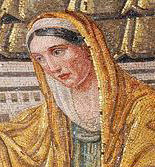Related Research Articles
Pope Felix I was the bishop of Rome from 5 January 269 to his death on 30 December 274.
Gavinus is a Christian saint who is greatly celebrated in Sardinia, Italy, as one of the Martyrs of Torres, along with his companions Protus, a bishop, and Januarius, a deacon.
Year 305 (CCCV) was a common year starting on Monday of the Julian calendar. At the time, it was known as the Year of the Consulship of Constantius and Valerius. The denomination 305 for this year has been used since the early medieval period, when the Anno Domini calendar era became the prevalent method in Europe for naming years.

Pope Soter was the bishop of Rome from c. 167 to his death in c. 174. According to the Annuario Pontificio, the dates may have ranged from 162–168 to 170–177. He was born in Fondi, Campania, today in the Lazio region of Italy. Soter is known for declaring that marriage was valid only as a sacrament blessed by a priest and also for formally inaugurating Easter as an annual festival in Rome. His name, from Greek Σωτήριος from σωτήρ "saviour", would be his baptismal name, as his lifetime predates the tradition of adopting papal names.

Lazica was the kingdom in the territory of west Georgia in the Roman/Byzantine period, from about the 1st century BC. Created as a result of the collapse of the kingdom of Colchis and the gaining of independence by the tribal-territorial units included in it in 131 ad.

Byzacena was a Late Roman province in the central part of Roman North Africa, which is now roughly Tunisia, split off from Africa Proconsularis.

February 10 - Eastern Orthodox liturgical calendar - February 12

Pudentiana is a traditional Christian saint and martyress of the 2nd century who refused to worship the Roman Emperors Marcus Aurelius and Antoninus Pius as deities. She is sometimes locally known as Potentiana and is often coupled with her sister, Praxedes the martyr.
The Scillitan Martyrs were a company of twelve North African Christians who were executed for their beliefs on 17 July 180 AD. The martyrs take their name from Scilla, a town in Numidia. The Acts of the Scillitan Martyrs are considered to be the earliest documents of the church of Africa and also the earliest specimen of Christian Latin.
Cyriacus, sometimes Anglicized as Cyriac, according to Christian tradition, is a Christian martyr who was killed in the Diocletianic Persecution. He is one of twenty-seven saints, most of them martyrs, who bear this name, of whom only seven are honoured by a specific mention of their names in the Roman Martyrology.

The Annuario Pontificio is the annual directory of the Holy See of the Catholic Church. It lists the popes in chronological order and all officials of the Holy See's departments. It also provides names and contact information for all cardinals and bishops, the dioceses, the departments of the Roman Curia, the Holy See's diplomatic missions abroad, the embassies accredited to the Holy See, the headquarters of religious institutes, certain academic institutions, and other similar information. The index includes, along with all the names in the body of the book, those of all priests who have been granted the title of "Monsignor".

February 11 - Eastern Orthodox liturgical calendar - February 13

Cremna or Kremna, was an ancient town in Pisidia. It is situated in the district of Bucak. It stands in a remote valley on a high plateau dominating the ancient Cestrus River, with limited access and good defensive features.
Orcistus or Orkistos was a city originally in the northeast of ancient Phrygia and later a bishopric in the Roman province of Galatia Secunda, situated south of the town now called Ortaköy, Afyonkarahissar, and previously Alikel Yaila.

Abitinae was a town in the Roman province of Africa Proconsularis and is famed for the Martyrs of Abitinae.

Restituta is a Berber saint and martyr of the Roman Catholic and Eastern Orthodox Churches. She was said to have been born in Carthage or Teniza and martyred under Roman Emperor Diocletian. The location and date of her martyrdom are not precisely known. She sometimes is considered one of the Martyrs of Abitinae, Roman Province of Africa, a group of North Africans including Dativus, Saturninus, et alia, who were martyred in AD 304.
Maximianopolis was an ancient city in Palaestina Secunda, within the Byzantine Empire. The name Maximianopolis was given to it by Diocletian, in honour of his co-emperor Maximian. It was located 17 M.P. from Caesarea and 10 M.P. from Jezreel. The town earlier bore the names Legio and Caporcotani.
The Diocese of Scythopolis is a titular see in Israel/Jordan and was the Metropolitan of the Roman province of Palestina II. It was centered on Modern Beth Shean (Bêsân).

The Three virgins of Tuburga were a group of young women who were executed for being Christians around 257 AD, in what was Roman-era Tunisia.
References
- ↑ Jean-Yves Congar, Encyclopedia of Christian Theology (Taylor & Francis 2004 ISBN 978-0-20331901-7). vol. 1, p. 499
- ↑ Annuario Pontificio 2013 (Libreria Editrice Vaticana 2013 ISBN 978-88-209-9070-1), p. 822
- ↑ Sancti Aureli Augustini Scripta contra Donatistas, pars I, p. 359
- ↑ Bleckmann, Bruno. "Diocletianus." In Brill's New Pauly, Volume 4, edited by Hubert Cancik and Helmut Schneider, 429–38. Leiden: Brill, 2002. ISBN 90-04-12259-1
- ↑ Santi Martiri di Abitina
- ↑ Dictionary of Christian Biography and Literature to the End of the Sixth Century A.D., with an Account of the Principal Sects and Heresies
- ↑ Dativo e i martiri di Abitina Archived September 1, 2008, at the Wayback Machine
- ↑ Santa Restituta d'Africa (o di Teniza)
- ↑ Martyrologium Romanum (Libreria Editrice Vaticana, 2001 ISBN 88-209-7210-7)